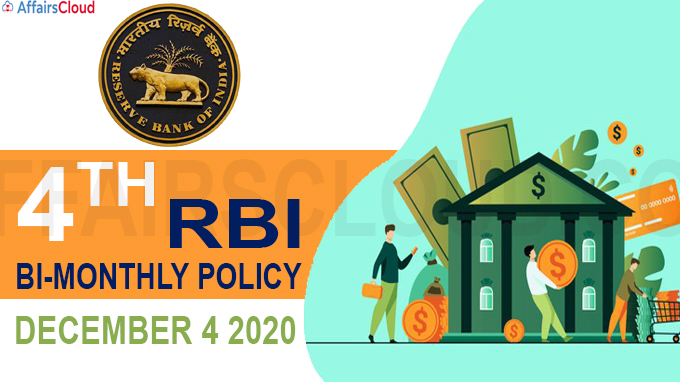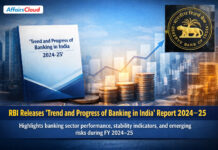
The 6-member Monetary Policy Committee (MPC) meeting of the Reserve Bank of India (RBI) was held from December 2-4, 2020 which was headed by RBI Governor Shaktikanta Das. The members of the committee are Dr. Shashanka Bhide, Dr. Ashima Goyal, Professor Jayanth R. Varma, Dr. Mridul K. Saggar, and Dr. Michael Debabrata Patra. It was the 4th Bi- Monthly MPC meeting.
During the meeting it was projected that the real GDP (Gross Domestic Product) growth will contract at 7.5% (-7.5%) in FY21. It is an upgrade in comparison to -9.5% in October MPC review.
- A record positive growth is expected in the H2FY21 (second half of FY2020-21) as the economy contracted by 23.9% (-23.9%) in the Q1FY21 but contracted 7.5% (-7.5%) in Q2FY21 amid Covid-19 pandemic.
- GDP growth for Q3FY21 (October-December) is placed at (+)0.1% and (+)0.7% in Q4FY21 (January-March).
- For H1FY22 (First Half of FY2021-22), it is forecasted at (+)6.5%.
- Consumer price index (CPI) inflation or retail inflation is projected at 6.8% for Q3FY21, 5.8% for Q4FY21; and 5.2% to 4.6% in H1FY22.
It was also decided to keep the rates unchanged which are as follows:
| Category | Rate |
|---|---|
| Policy Repo Rate | 4.0% |
| Reverse Repo Rate | 3.35% |
| Marginal Standing Facility (MSF) Rate | 4.25% |
| Bank Rate | 4.25% |
Key Points:
–CPI inflation rose sharply to 7.3% in September 2020 and further to 7.6% in October 2020.
–Food inflation surged to double in October 2020 across protein-rich items including pulses, edible oils, vegetables and spices on multiple supply shocks.
–Core inflation, i.e., CPI excluding food and fuel, also picked up from 5.4% in September 2020 to 5.8% in October 2020.
–As on November 27, 2020, reserve money increased by 15.3% year-on-year.
–The manufacturing and services purchasing managers’ index (PMI) at 56.3 and 53.7 respectively in November 2020.
–Money supply (M3) grew by only 12.5% as on November 20, 2020.
–India’s exports fell 9% to USD 23.43 billion in November 2020 on an annual basis due to a drop in shipments of segments such as petroleum products, engineering and chemicals..
–Corporate bond issuances stood at Rs 4.4 lakh crore during April-October 2020 as against Rs 3.5 lakh crore during the same period of 2019.
–India’s foreign exchange reserves were US$ 574.8 billion as on November 27, 2020.
–RBI to extend TLTRO to 26 sectors from 5 sectors
The Committee has decided to extend on-tap Targeted Long-Term Repo Operations (TLTRO) by bringing 26 stressed sectors identified by the Kamath Committee under the chairmanship of Kundapur Vaman Kamath in order to provide more liquidity in the economy.
- This decision has been taken after the launch of Emergency Credit Line Guarantee Scheme 2.0 (ECLGS 2.0) as a part of Atmanirbhar Bharat Package 3.0 announced on November 12, 2020. Click Here to Read
- This extension will encourage banks to combine both schemes by availing funds from RBI under on tap TLTRO and seek guarantee under ECLGS 2.0 to provide credit support to stressed sectors.
Background:
On October 9, 2020, RBI decided to conduct on-tap targeted long-term repo operations (TLTRO) worth Rs 1 lakh crore with tenors of up to three years at a floating rate linked to the policy repo rate till March 31, 2021.
- In this regard on October 21, 2020 RBI brought five sectors under it viz. Agriculture; agri-infrastructure; secured retail; micro, small and medium enterprises (MSMEs); and drugs, pharmaceuticals and healthcare.
- Currently, liquidity availed by banks under on-tap TLTRO scheme is to be deployed in corporate bonds, commercial paper and non-convertible debentures issued by the entities in specific sectors over and above the outstanding level of their investments in such instruments as on September 30, 2020.
What are targeted long-term repo operations (TLTRO)?
LTRO is a tool that lets banks borrow one to three-year funds from the central bank at the repo rate, by providing government securities with similar or higher tenure as collateral. This simulates bank lending which leads to efficient liquidity in the economy.
–RBI allowed RRBs to access LAF, MSF and Call or Notice Money Market Windows
The RBI allowed Regional Rural Banks (RRBs) to access the liquidity adjustment facility (LAF), marginal standing facility (MSF) and call or notice money market to facilitate better liquidity management.
- In the in the Call/Notice money market, RRBs can participate as both as borrowers and lenders,
- Detailed instructions in this regard will be issued shortly
Static Points:
MSF: It is the rate at which the banks are able to borrow overnight funds from RBI.
LAF: It is a tool used in monetary policy by RBI enabling banks to borrow money through repurchase agreements. It is used to aid banks in adjusting the day to day mismatches in liquidity.
Call/notice/term money market: It facilitates lending and borrowing of funds between banks and entities. An institution which has surplus funds may lend them on an uncollateralized basis to an institution which is short of funds.
- The call money is usually availed for one day. If the bank needs funds for more days (2-14 days), it can avail money through the notice market.
- Term money refers to borrowing and lending of funds for a period of more than 14 days.
–RBI to review guidelines on credit default swaps
RBI announced a review of the guidelines on credit default swaps (CDS) to facilitate the development of the credit derivatives market. The draft directions for the same will be issued shortly.
- A CDS is an OTC (over-the-counter) derivative in which a protection seller commits to compensate the protection buyer for any loss resulting from a credit event. It is essential for protection against interest volatility on lower rated papers.
- The last CDS guidelines were issued in January 2013.
Static Points:
–A derivative is a financial instrument with a price that is based on a different asset. Its value is derived from the underlying assets.
–An OTC derivative is traded between two parties without going through an exchange or other intermediaries.
–RBI asked banks not to make any dividend payment for FY20
In view of the ongoing economic stress amid COVID-19 pandemic, RBI asked scheduled commercial banks (SCBs) and co-operative banks not to make any dividends for the financial year ended March 2020 (FY20). This will allow banks to economize capital and absorb losses, if any. This decision has been taken after the review of Q2FY21. Guidelines for the same will be issued shortly.
- RBI will also issue guidelines for non-banking financial companies (NBFCs) with regard to distribution of dividend as per a matrix of parameters. Currently there are no guidelines for NBFCs for dividend distribution.
Background:
In April, 2020 RBI had announced that SCBs and cooperative banks will not make any dividend payouts from profits pertaining to FY2020, until further instructions, which will be reassessed in the quarter ending September 30, 2020 (Q2FY21).
–Large NBFCs to come under tighter RBI scrutiny
The apex bank has announced measures for non-banking financial companies (NBFCs) in order to improve their governance standards and for effective risk management and internal controls.
As a part of this, NBFC’s regulatory regime will be reviewed, which is based on the principle of proportionality. A discussion paper on this will be issued before January 15, 2021, for public comments
–Strengthening Audit Systems of Supervised Entities by RBI
RBI is focused towards strengthening the governance and assurance functions in supervised entities (SEs). RBI announced to bring the standard of supervision of UCBs and NBFCs proportionately at par with that for commercial banks. The weakness in three lines of defence mechanism is adversely affecting UCBs and NBFCs These three lines of defence are: business unit itself; risk management and compliance; and internal audit.
- It was also decided to issue guidelines to large UCBs and NBFCs on adoption of Risk Based Internal Audit (RBIA). This will enable the creation of an independent risk focused internal audit system.
- A decision was also taken on harmonizing the guidelines on appointment of Statutory Auditors for commercial banks, UCBs and NBFCs. The new guidelines will enable SEs to appoint the audit firms as per their needs in a timely, transparent and effective manner.
–RBI to undertake closer Scrutiny of Shadow Lenders, Local Banks
In bid to improve supervision of the financial sector, RBI will undertake closer scrutiny by implementing risk-based audits of shadow lenders (intermediaries) and large UCBs that focus on localized lending.
- This decision comes after the deterioration of India’s financial sector that led to the bankruptcy of two major finance firms and the rescue of a couple of banks.
- It is expected that bad loans will reach a two-decade high of 5% of credit by March, 2020.
–RBI to set digital payment security control rules
The central bank will also put in place minimum security standards for payment systems, following a surge in digital transactions during the pandemic. This decision is aimed at ensuring that digital transactions such as Net banking transfers, mobile banking, UPI, card payments etc. can be made more securely without the risk of fraud and failure rate
- In this regard, the Central bank will issue Reserve Bank of India (Digital Payment Security Controls) Directions, 2020 for regulated entities to set up a robust governance structure for such systems.
–RBI strengthens grievance redress framework of banks for better service
With a view to strengthen and improve the internal grievance redress mechanism of the banks and to provide better customer service, it has been decided to put in place a comprehensive framework comprising the following:
- Enhanced disclosures on customer complaints
- Monetary disincentives in the form of recovery of cost of redress of complaints
- Undertaking intensive review of grievance redress mechanisms and supervisory action against regulated entities failing to improve their redress mechanisms
The framework would be put in place during January 2021.
–RTGS to be 24/7, contactless card payment hiked to Rs 5,000 from Rs 2,000
RBI also announced to increase the limit for contactless card transactions and recurring payment mandates through cards and unified payments interface (UPI) to Rs 5,000 from Rs 2,000 earlier from January 2021
- It also made real-time gross settlement (RTGS) transactions available on a 24×7 basis.
- RTGS is meant for large-value transactions. The minimum amount that can be remitted through RTGS is Rs 2 lakh with no upper limit.
- RBI had already allowed transfer of funds via National Electronic Funds Transfer (NEFT) system on a 24x7x365 basis from December 2019.
–RBI expects positive growth in second half of 2020-21
RBI expects the economy to record positive growth in the second half of the FY21. The economy contracted by 23.9%(-23.9%) in the first quarter and 7.5% in the second quarter on account of the COVID-19 pandemic. In October, the RBI had projected the contraction in gross domestic product (GDP) at 9.5%.
–RBI projects 6.8% retail inflation in December quarter
RBI said retail inflation is likely to remain elevated and pegged it at 6.8 per cent for the third quarter of the current fiscal. However, retail inflation is projected to be 5.8 per cent in the fourth quarter of 2020-21.
Static Points:
Repo Rate: It is the rate at which RBI lends money to commercial banks.
Reverse Repo rate: It is the rate at which RBI borrows money from commercial banks.
Cash Reserve Ratio (CRR): The share of net demand and time liabilities (deposits) that banks must maintain a cash balance with the RBI.
Statutory Liquidity Ratio (SLR): The share of net demand and time liabilities (deposits) that banks must maintain in safe and liquid assets, such as government securities, cash, and gold.
Bank Rate: It is the rate at which the RBI is ready to buy or rediscount bills of exchange or other commercial papers for the long term.
Recent Related News:
i.In accordance with the latest data of Reserve Bank of India (RBI), between 2015-16 and 2019-20, digital payments increased at a compounded annual growth rate of 55.1% from 593.61 crore in FY2015-16 to 3,434.56 crore in FY19-20. In absolute terms, this value has grown from Rs 920.38 lakh crore to Rs 1,623.05 lakh crore during this period at an annual compounded rate of 15.2%.
ii.On October 22, 2020, RBI issued the revised regulatory framework for housing finance companies (HFCs) under which the minimum net owned funds (NOF) size for HFCs is fixed at Rs 25 crore.
About Reserve Bank of India (RBI):
Headquarters– Mumbai, Maharashtra
Formation– 1 April 1935
Deputy Governors– 4 (Bibhu Prasad Kanungo, Mahesh Kumar Jain, Michael Debabrata Patra, M. Rajeshwar Rao)




